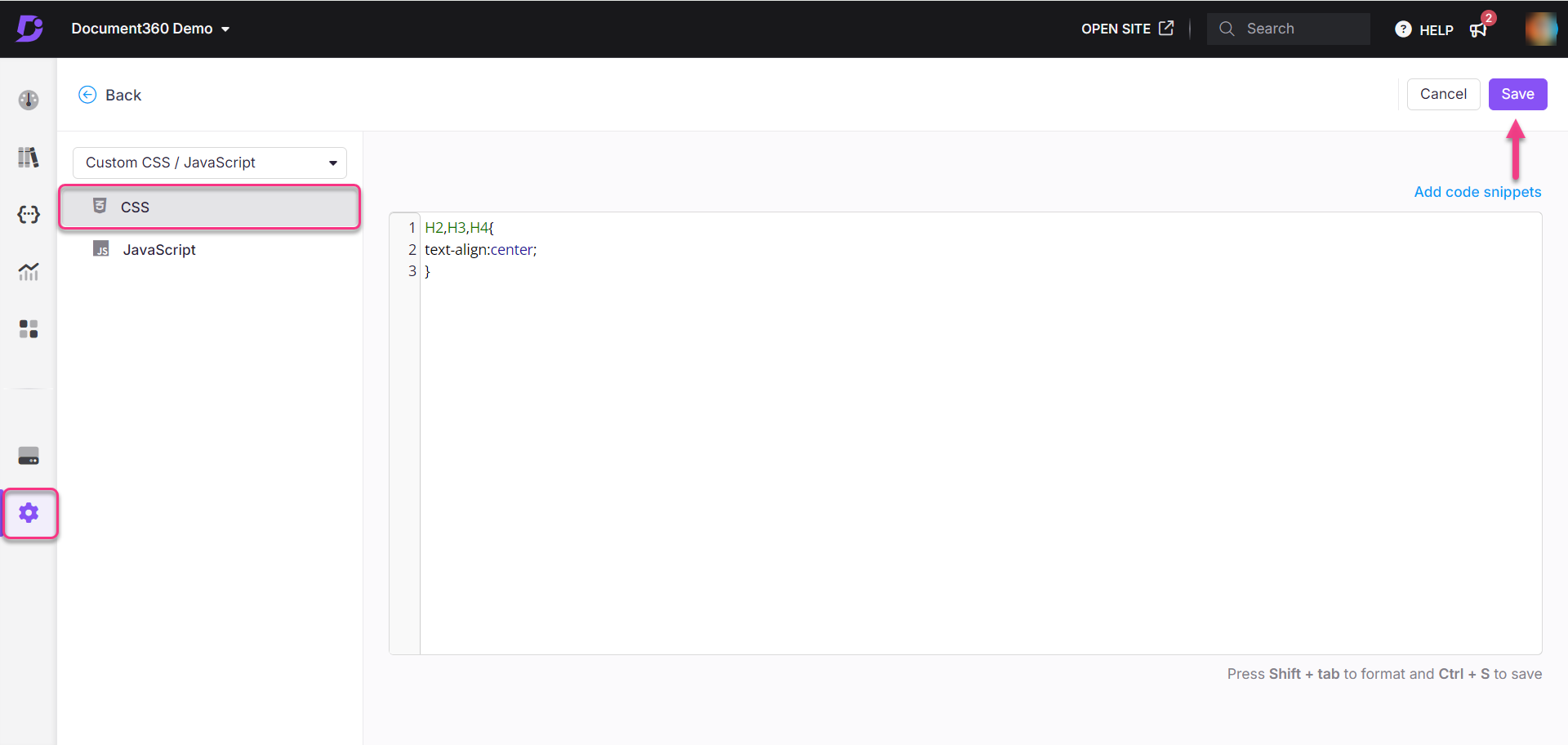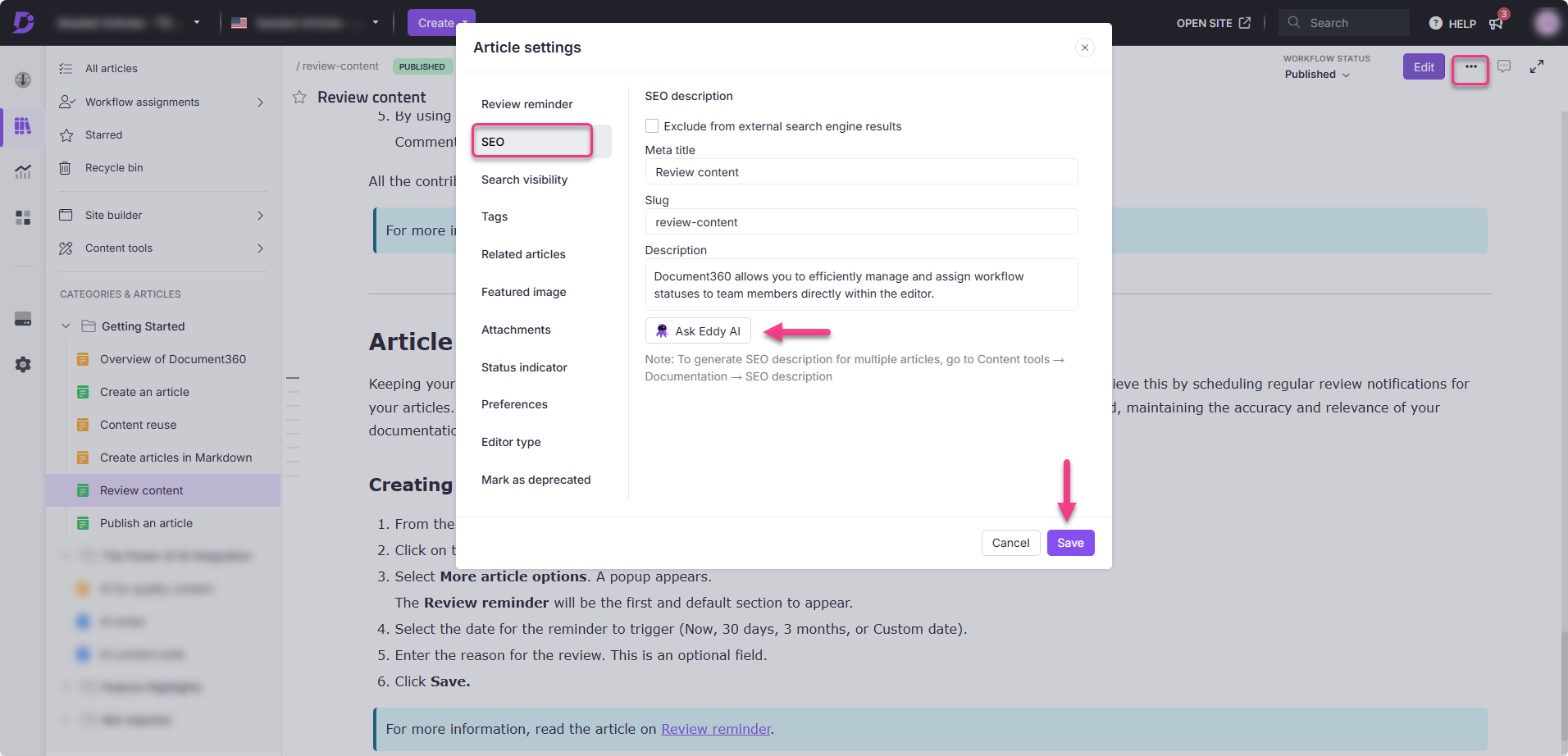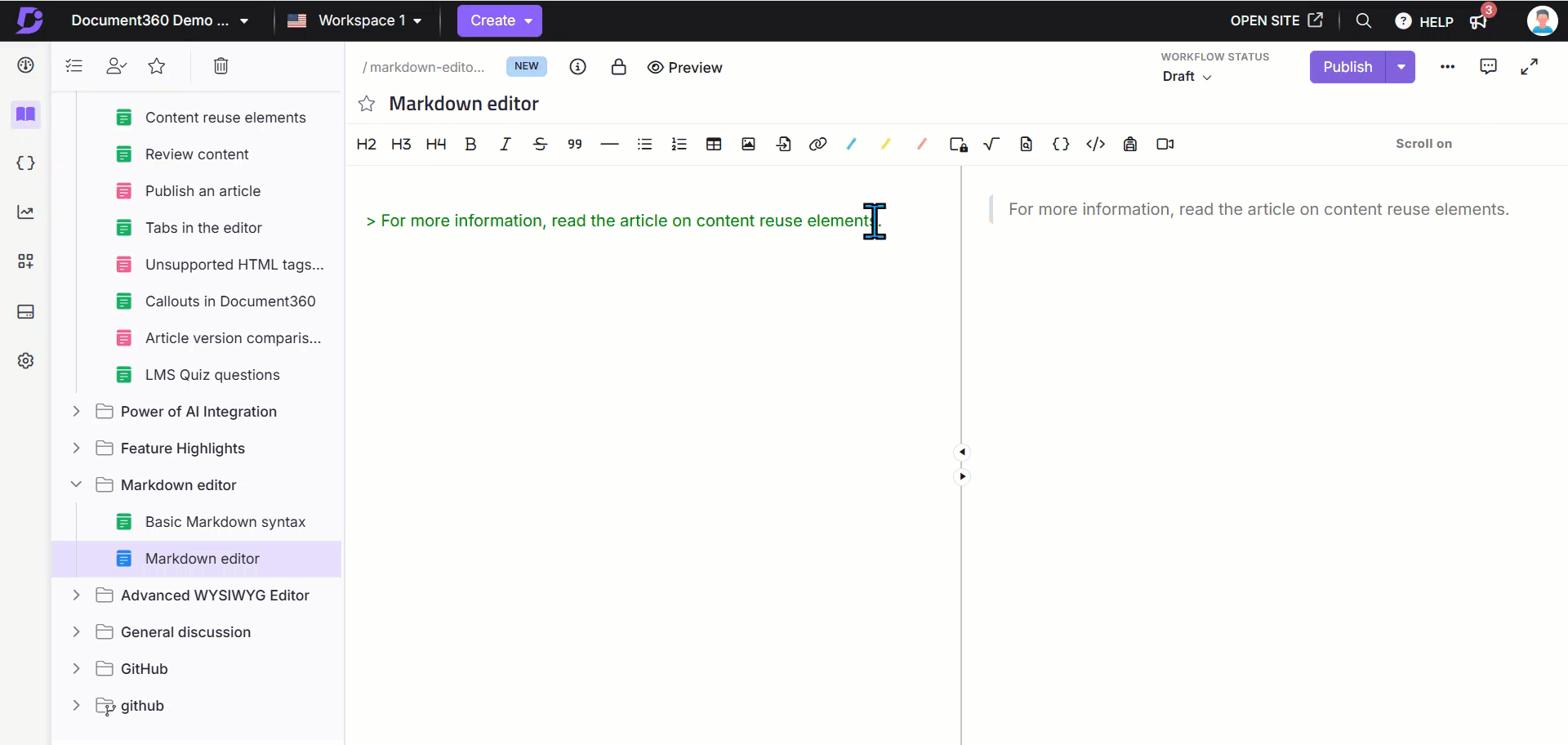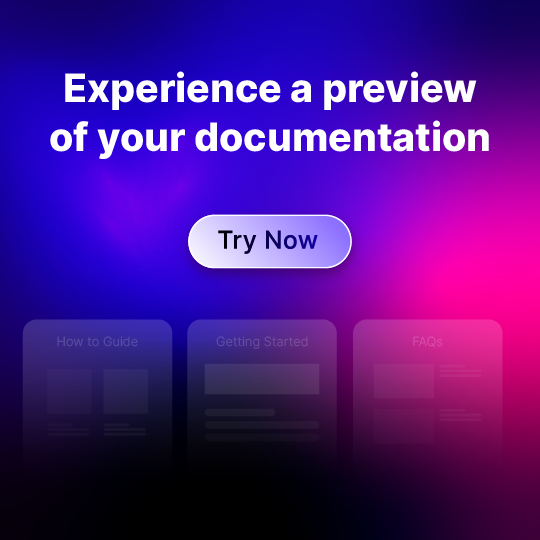Most tech docs fail not because writers can’t write, but because the documentation process actually sucks. Signs of no authority in the team, making last-minute updates only when the customer points out a flaw, and stillness in the name of strategy. That’s a recipe for disaster. A solid content strategy flips the script, making docs easier to create, reuse, and worth reading.
📝 TL;DR
- Lack of strategy results in wasted effort, says content marketers.
- Notion’s documentation strategy drove 95% of organic traffic and over 30 million users.
- A strong document strategy involves content reuse, multi-channel delivery, and single-source publishing.
- Pillars: Know your audience, structure topics, and follow the content lifecycle.
- SEO makes docs discoverable → structure, metadata, linking, FAQs, canonical tags.
- Tools like Document360 simplify collaboration, reuse, and accessibility with AI-powered features.
Do you know? 43% of content marketers admit that ‘lack of strategy’ sinks their content efforts.
Well, strategies fail all the time. You build one, it fails, and you move. Simple enough.
However, completely neglecting your technical content strategy leaves you with a leaky bucket.
It stalls the knowledge-sharing spirit, business scale at turtle speed, and your team is stuck in an infinite loop of solving the same old customer problems. All efforts go in vain.
You don’t want that. Ain’t you?
🍪 A Motivating Cookie
A rich documentation strategy boosted 95% of Notion’s traffic organically. Not only this, but comprehensive documentation also enabled users to become power users faster, and a systematic approach to preserving and transferring knowledge ultimately led to over 30 million users and 4 million paying subscribers benefiting from this infrastructure.
In this article, we’ll cover how you can create a goldmine technical documentation strategy, why it matters, key pillars of document strategy, and how it’ll benefit you in the long run.
Basics first, we bet you don’t know the exact definition.
What Is Content Strategy?
A content strategy is a guiding framework that involves planning for creating content, identifying for whom it’s made, along with a distribution plan, and maintaining content that aligns with your business goals.
Content strategy helps to hit all the right spots. It takes you closer to buyers’ decisions. Strive to find the right ideal customer, boost your product revenue, and gain insight into why they make a purchase. Let’s go beyond the umbrella term.
To create a content strategy that covers all four corners, you need to understand a few things:
- Who are the users you’ll serve? Once you identify them, how do you cater to them?
- What are the key pain points you should focus on when developing strategy documentation?
- How many new customers are needed to achieve growth goals
- How that strategy documentation will be created, maintained, and measured
- How long (or short) the sales process is for the average deal
There are many more to it, but these are the surface-level critical questions that need to be tackled firsthand. Later in the blog, we’ll cover the nitty-gritties that take down the water to SEO for documentation, content lifecycle, and much more.
Why It Matters for Technical Documentation
We highlighted a few benefits:
Enables content reuse formats.
A technical content strategy helps to break down different pieces that originate from the original guide or content. You can repurpose one content idea into multiple posts.
For example, reuse your hosted content in form developer guides, API references, in-app tooltips, and PDFs.
Yet many B2B companies get this wrong. It’s often misunderstood as reusing the duplicate content on different channels simultaneously (that’s crossposting), which is not what you’ve misled.
With an unshakable content strategy, you don’t have to struggle to come up with new content every time a customer query arises.
Instead of getting worked up and performing a knowledge base search, like finding lost airport luggage at the airport. (slight chances to be seen). Build a lifecycle of content reuse. Start with audience pain points—layer in your unique insights. Create one deeply researched piece and then reuse it across various formats.
Supports multi-channel delivery
“Be where your customers are,” they say.
However, you can’t show up if you don’t know where they congregate. That’s where a solid technical content strategy comes in. It’s not just about documents; it’s about understanding your ideal customer, their purchasing motivations, when they make a purchase, and what they need in between.
Primarily, what form of content they engage with. Readers may prefer downloading help docs in PDF, EPUB, or MOBI formats,
A good strategy makes everything click. It keeps your content consistent, scalable, and value-driven. Provide a preferred channel for your audience, such as a website, app, or internal knowledge base, to engage with your content. Not a single channel, like an HTML-only documentation site.
However, a narrow approach in content marketing can create chaos, like outdated pages, mixed messages, and wasted effort. It serves a poor experience to the audience who are looking for quick downloads, interactive demos, or contextual help.
Improves efficiency and reduces duplication.
Multi-format support backed by a content strategy reduces duplication by enabling single-source publishing. Instead of creating separate versions of the same content for each format—like writing one guide for the website, another for PDF, and another for in-app help—you author content once in a structured, centralized system.
From there, the same content can be automatically output to multiple formats (HTML, PDF, in-app widgets, API portals) without manual rewriting. This eliminates:
- Rework: Teams don’t waste time duplicating effort across channels.
- Version conflicts: Everyone pulls from the same source, so no “one doc says X, another says Y.”
- Maintenance headaches: Update one place, and all formats stay aligned.
This approach ensures consistent, lean documentation that is easier to maintain, while freeing teams to focus on improving content quality rather than managing multiple disconnected copies. Well, we made reasonable assumptions that technical content strategy matters, but when you scroll down, we’ve covered how a killer strategy is built.
Key Pillars of a Documentation Content Strategy
Audience roles and documentation types
40% of content professionals confess that they weren’t doing nearly enough audience research. Theories emerged because they didn’t know how or were too swamped with other work. It’s essential to understand your audience (developer, admin, end-user) and tailor tech docs accordingly.
Different types of documents serve various purposes. Your internal documents can serve as SOPs, PRDs, and process guides, keeping the team in sync. Whereas external documents are customer-facing and include quick-start guides, troubleshooting manuals, and API references.
External users expect information to be self-served, rather than relying on email documentation that fills their inbox. Prioritize content-audience fit. Without it, you’ll lose audience connection, which means you won’t achieve their desired outcomes.
Side note: Remember that what content strategy worked for one set of audiences doesn’t guarantee it works for all. It’s context-dependent, not format. Without a tailored strategy, even the most amazing content is likely to flop.
Topic architecture: core, supporting, reference
With product maturity, users require clear documentation to build trust. A rooted technical content strategy helps to update the documentation with layered information, which is easy to unfold for team members and separated into three tiers: Core, Supporting, and Reference.
Let’s break it down:
- Core: Core docs are the basics. It includes what the product is about and how to get started. For example, how to install and operate the product, and what features it covers.
- Supporting: Support documents primarily cover help guides, including tutorials, FAQs, troubleshooting, escalation flows, edge cases, and best practices.
- Reference: These docs touch on topics like API schemas, decision metadata, and command lists.
This architecture helps writers to plot new content where it belongs, avoid duplication, and navigate readers.
Content lifecycle: create → review → maintain → archive
Documentation is a living system; it needs constant updates. It’s an ongoing building, not a one-time thing. Docs need continuous development to stay useful. To stay updated, you need to follow a content lifecycle where you timely create>review>maintain> and archive.
Be mindful while you create. Don’t bombard information in the first draft. Take a fresh set of data from the developers and keep on creating new content.
“Build docs focused on eliminating blockers in order of complaint volume, not marketing roadmap.” — Ninad Pathak, Technical Writer at Digital Ocean
Next comes the review stage – try to bring more eyeballs (SMEs, peers, fresh hires) on your documented content to validate the truthfulness of the content. Once you’re done with the building stage, keep maintenance of your documentation. Remove outdated content that no longer adds value. Perform check-ins and update new policies, if any API changes, or product screenshots.
Later spot issues with the outdated doc that may confuse readers. Delete or archive docs with zero page views in the last six months.
Pro tip 💡 For backup, add deleted doc titles in your internal changelog, just in case a customer comes back looking for breadcrumbs, prioritize that topic if needed.
Turn your technical documentation into a growth engine with Document360’s AI-powered platform.
Book A Demo
SEO for Documentation: Make Your Docs Discoverable
SEO tactics are crucial for obtaining quick and relevant search results. While crafting tech docs, the technical writer must keep these practices in mind:
Structure with Headings (H1, H2, H3)

Break sections into H2/H3 subheadings to organize subtopics and make content more digestible. Add keywords naturally in the headers to avoid keyword stuffing. A structured doc will help you index for search.
Write Metadata That Clicks

Your meta tags, like title and meta description, are often the only things users see in search results. Keep your titles under 60 characters, descriptions under 160. Check the performance of your metadata and tweak if it’s low on impressions.
Build Internal Linking Paths

Link to related guides so readers (and Google) see connections across your docs.
Also, add external links to authoritative sources—but use sparingly (2–3 per 1,000 words). Use descriptive anchor text to add links instead of simply clicking here or read now.
Pro tip 💡: Always internally link between the relevant pages, even if they’re in different sections of your site.
“With internal linking you can really kind of focus things on those directions and those parts of your site.” — John Mueller, Google
Add FAQs for Real User Queries

Add FAQs for unresolved queries in your documentation. It helps to answer the user queries that you may miss, explaining the surface-level questions. Keep the questions straightforward and natural.
Use Canonical Tags for Versions
Ensure that your URLs are relevant and logical. This helps both users and Google determine which version to rank. Canonical tags help to send a signal to the primary version to seek the value of SEO. Use 301 redirects for outdated or deleted content.
Maintain a Sitemap & Robots.txt
Be a mix of content SEO and technical SEO. Optimize for mobile first and aim for less than 3 seconds. Submit to Google Search Console for XML and HTML sitemaps so that users can find all pages. Control which search engine indexes with Robots.txt – remove duplicate pages.
Docs-as-Code and Tooling for Writers
Modern documentation does all the heavy lifting via software workflows.
Docs-as-Code is a technical approach to documentation, where documents are stored in Git, written in Markdown, and published through CI/CD pipelines.
But as one first-time tech writer put it: “The developers are pushing for Docs-as-Code, but I’m worried it’ll be too technical for non-dev stakeholders. I don’t want to spend weeks setting up pipelines and end up with no actual docs written.”
Well, the sentiment is humdrum—tooling shouldn’t be a roadblock.
Redditors put it out: “Start small. Don’t over-engineer… You can always migrate later,” while another admitted, “I spent more time fiddling with MkDocs themes than actually writing.”
That’s where choosing the optimal technical writing tool is kind of a big deal. Platforms like Document360 or GitBook make collaboration easier, while ReadTheDocs is well-suited for development-heavy teams.
Few teams successfully integrate Git for API documentation, a platform for user guides, and a content delivery system that flows like liquid.
Style, Tone & Accessibility
It’s not about creating documentation, but about ensuring it actually creates business value. Other than writing style, tone and accessibility are high notes, not to be missed.
Plain Language for Complex Concepts
Translate technical details into clear, concise explanations. Readers should feel smarter after reading it, not more confused than they already are. Give a lot of references and examples while designing your strategy for writers to get the feel of your documentation tone.
Technical writing is about making the complicated simple, adjusting words so anyone can understand.
As much as possible, cut the fluff and make the message sharper so that the digestion of information becomes easy.
Accessibility Best Practices
- Use more visuals; they simplify tricky steps.
- Make the document accessible with proper use of keywords in the headings.
- Hyperlink digital documents for easy navigation,
- Do not forget the Alt text for images.
- Structure document with H1, H2, H3 levels
- Add alt text for images,
- Create a table for visual depth, and add readable fonts for screen reading compatibility.
- Add video captions, transcripts, or audio descriptions for better accessibility.
Inclusive Technical Writing
Keep the end user in mind. Always write without assuming users’ experience levels or background.
WCAG includes standards to ensure your documents are accessible, also fostering inclusivity and making them usable for everyone regardless of their disabilities.
Final Words
Now you know the drill and reason behind why having a strong documentation strategy is important. The struggle to consistently produce content for technical expertise, optimizing for search, and delivering simple yet efficient content– all run behind an effective content strategy. The bigger issue lies in equipping marketers and technical writers with the right technical tools to meet evolving documentation standards.
In conclusion, it’s time to treat documentation as growth infrastructure, and with platforms like Document360, you get:
- Idea generation, outlines (via AI tools like Eddy AI)
- AI to summarize documents in a format that you can easily read
- Producing first drafts for you and helping with rephrasing and tonality.




 –
– 

